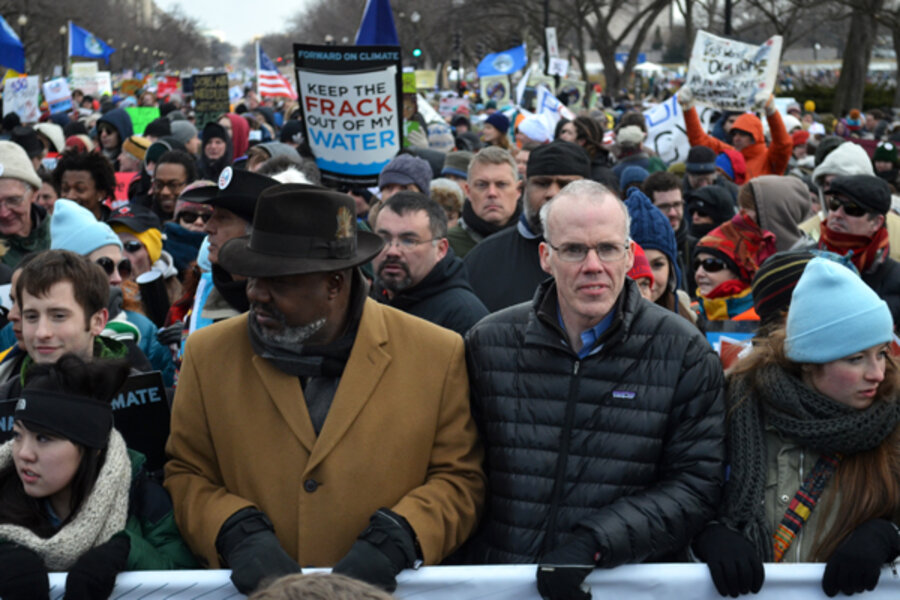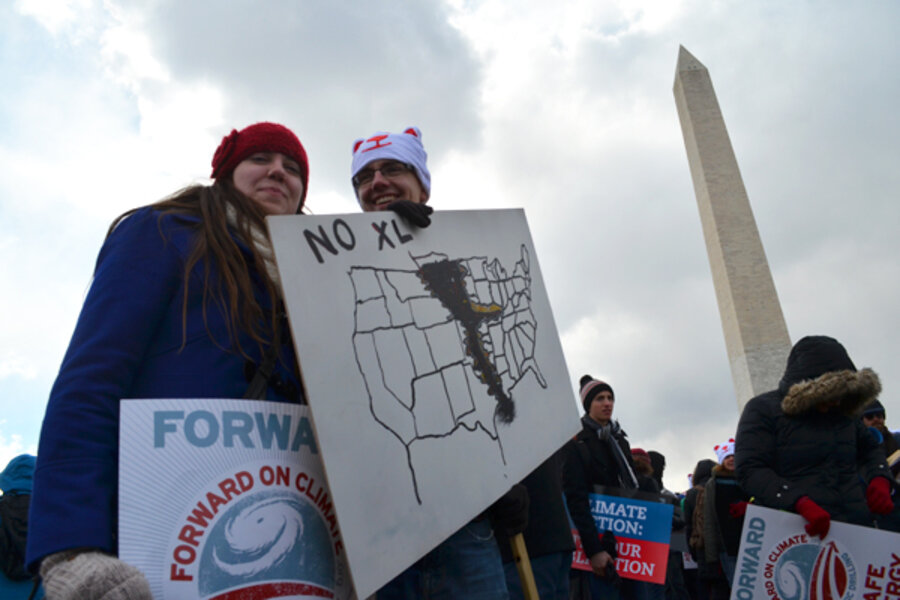Climate rally: How a pipeline became Public Enemy No. 1
Loading...
| Washington
[Editor's note: A paragraph in the original was removed to avoid giving the impression that stopping the pipeline would have no effect on tar-sands producers.]
Tens of thousands of protesters marched on Washington Sunday, in what organizers say was the largest climate rally in US history. They had varying agendas but unified on one point: Blocking construction of the Keystone XL pipeline.
“When you are in a hole, stop digging,” Bill McKibben, cofounder of the environmentalist group 350.org,, told the crowd gathered on the National Mall. “Above all, stop the Keystone [XL] pipeline. The president can do that with a single stroke of a pen, and it would make him the first world leader to veto a project because of climate change.”
As a symbol of what's wrong with America's (and the world's) oil-dependent ways, Keystone XL is a useful adversary. It would take the oil derivative from Alberta's tar sands (an especially energy-intensive process), transport it through the Great Plains, and down to Gulf Coast refineries. It's a concrete target for environmentalists, clean-energy supporters, and climate activists to rally around. There are potential spills that worry landowners near the pipeline. Keystone XL poses an immediate threat in a way that melting glaciers in the Arctic or rising temperatures globally never have.
But the Keystone strategy is also risky because it isolates the protesters from other potential allies, such as unions and energy security advocates. And it puts the Obama administration on the spot at a time when the economy is weak and it is anxious to create jobs.
"While there might be a small handful of people that object [to Keystone XL], there's 20,000 Americans out there right now who are anxious – some are desperate – to have these opportunities to feed their families, to heat their homes, to prepare for their future, to send their kids to school, etc.," said Jack Gerard, CEO of the Washington-based American Petroleum Institute (API), in a conference call with reporters last week in anticipation of the protests. "So while there might be a few people that come to town to express their views or stage tactical efforts to draw attention to a very small handful of people, there's hundreds of thousands of Americans that are very supportive of [Keystone XL]."
Sunday's climate rally, however, was anything but small. Despite biting cold and strong winds, tens of thousands of protesters rallied on the National Mall. Organizers put the number at more than 40,000. Police did not provide an estimate. The demonstrators hoisted signs decrying potential environmental impacts of tar sand development and hydraulic fracturing.
“We wouldn’t consider ourselves ultra-environmentalists,” said Daniel Bedsaul of Radford, Va., holding a hand-drawn map of the United States with a thick, black morass of oil seeping from around the proposed pipeline’s path. “But we’re definitely concerned,” added Brenna Ishler, also of Radford. They're concern: the threat of a spill from the pipeline.
Official environmental reviews of potentially damaging projects have become too rushed and narrow in recent years, said Vince Skinner, who traveled from Windsor, Ontario, to Michigan to catch a bus to the rally in Washington. And he’s unnerved by signs of a changing climate. “My tulips are sprouting in the ground in January,” he said. “That’s crazy.”
Van Jones, a member of the Natural Resources Defense Council’s board of trustees and a former environmental adviser to President Obama, addressed the chief executive directly in his remarks: "President Obama, all the good that you have done, could do, or imagine doing will be wiped out by floods, fires, and superstorms if you fail to act now to deal with this crisis."
After the speeches, the throng embarked on a march around the White House, chanting “Barack Obama / Yes you can / Stop the dirty pipeline plan,” among a myriad of other slogans.
The march climaxed in a “human pipeline.” Demonstrators held above their heads jet black signs to resemble a long, black pipe from the sky.
It’s an image the oil and gas industry has spent millions in advertising and lobbying trying to combat. Calling Keystone XL the most thoroughly vetted major infrastructure project in the nation's history, they point to at least two extensive government environmental reviews that have concluded the pipeline would result in minimal environmental impacts.
An additional review from the US State Department is expected sometime soon.
Unions, who are sometimes allies with environmentalists on issues, are taking the opposite side this time, in part because of the huge number of jobs involved in the project.
"The men and women of America's building trades unions, who will actually work on this project, are the safest, most highly skilled and productive pipeline workers found anywhere in the world,” said Sean McGarvey, president of the AFL-CIO’s building and construction trades department, in the API teleconference with reporters last Wednesday. “I can assure you that they will perform their crafts with the utmost diligence and with a keen eye on protecting our environment and natural resources."
Some 69 percent of respondents supported construction of the pipeline, according to a new poll by Harris Interactive, while 17 percent oppose it.
One member of Congress, Sen. Sheldon Whitehouse (D) of Rhode Island, spoke at the rally, Reuters reported. But in January, 44 Republican and nine Democratic senators nine Democratic senators urged Mr. Obama to approve the $5.3 billion project.








